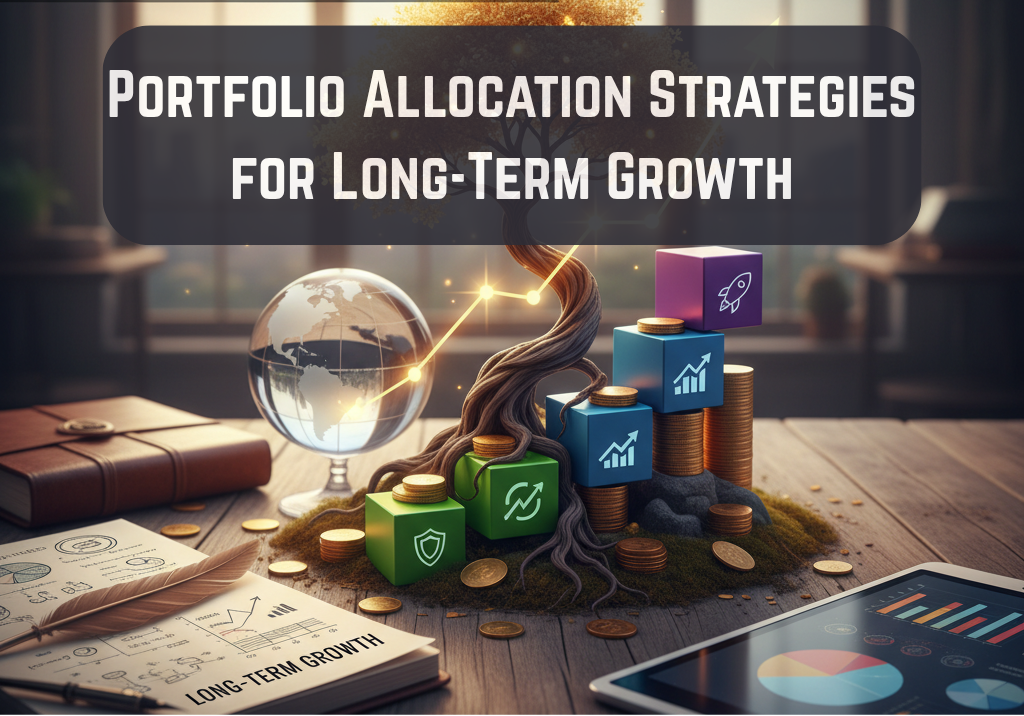
Portfolio Allocation Strategies for Long-Term Growth
Portfolio Allocation Strategies for Long-Term Growth
Building wealth in the stock market isn’t just about picking the right stocks — it’s about allocating your investments wisely across different assets. Portfolio allocation plays a critical role in managing risk, ensuring stability, and achieving long-term growth.
Thank you for reading this post, don't forget to subscribe!In this blog, we’ll break down what portfolio allocation means, why it’s important, and how to craft a strategy suited for your goals and risk tolerance.
What is Portfolio Allocation?
Portfolio allocation refers to the process of dividing your investments among various asset classes such as equities, debt, gold, real estate, and cash equivalents. The goal is to balance risk and reward by spreading your money across different instruments.
The right mix depends on your:
-
Financial goals (e.g., retirement, home, education)
-
Investment horizon
-
Risk appetite
-
Market conditions
Why Portfolio Allocation Matters
A well-diversified portfolio ensures that a downturn in one asset class doesn’t derail your entire investment plan.
For instance, when equities are volatile, debt or gold often provides stability — helping you stay invested and avoid panic decisions.
Key benefits include:
-
Reduced portfolio risk
-
Consistent long-term returns
-
Protection from market volatility
-
Better alignment with financial goals
Popular Portfolio Allocation Strategies
Let’s explore some proven strategies investors use to build long-term wealth:
1. The 60/40 Strategy (Equity–Debt Mix)
A classic allocation model — 60% equities and 40% debt — balances growth and safety.
Equities drive long-term capital appreciation, while debt instruments like bonds or fixed deposits provide stability.
Best For:
Moderate investors seeking growth with manageable risk.
2. The Aggressive Growth Strategy
If you have a high-risk appetite and a long-term horizon (10+ years), allocating 80–90% of your portfolio to equities can maximize growth potential.
Suggested Mix:
-
80% Equity (Large-cap, Mid-cap, and Global funds)
-
15% Debt
-
5% Gold or Alternatives
Best For:
Young investors or those with long investment horizons.
3. The Conservative Strategy
This model prioritizes capital preservation.
You might allocate 70–80% of your portfolio to low-risk assets like debt, gold, or fixed income, and the remaining in equities for moderate returns.
Best For:
Retirees or investors with short-term financial goals.
4. The Core-Satellite Strategy
This approach combines stability and opportunistic growth.
-
The core (70–80%) includes long-term, stable investments like index funds, large-cap stocks, or government bonds.
-
The satellite (20–30%) is for high-growth opportunities like mid-caps, small-caps, or thematic funds.
Best For:
Investors seeking balance between safety and alpha generation.
5. The Age-Based Rule (100 – Age Formula)
A simple yet effective guide.
Equity allocation = 100 – your age
For example, if you’re 30, you can allocate 70% to equities and 30% to debt or safer instruments. As you age, you gradually reduce exposure to volatile assets.
Best For:
Those seeking a dynamic, self-adjusting allocation plan.
Sample Portfolio Allocation Table
| Investor Type | Equity (%) | Debt (%) | Gold (%) | Others (%) | Risk Level |
|---|---|---|---|---|---|
| Aggressive | 85 | 10 | 5 | 0 | High |
| Moderate | 60 | 30 | 10 | 0 | Medium |
| Conservative | 30 | 60 | 10 | 0 | Low |
Tips to Build a Strong Long-Term Portfolio
-
Rebalance Quarterly or Annually: Adjust allocations as market values shift.
-
Diversify Across Sectors: Don’t rely on one sector (like IT or Banking) alone.
-
Include International Exposure: Global diversification can protect from domestic slowdowns.
-
Stay Disciplined: Avoid reacting emotionally to short-term market movements.
-
Review Goals Regularly: Adjust your portfolio as life goals evolve.
Final Thoughts
Portfolio allocation isn’t a one-time exercise — it’s an ongoing process of aligning your investments with your goals and risk tolerance.
The key to long-term growth lies in diversification, discipline, and periodic review.
Whether you’re a young investor just starting or a seasoned one approaching retirement, following a structured allocation strategy can help you ride out market cycles and build lasting wealth.
Related Blogs:
How to Review & Rebalance Your Portfolio Quarterly
Portfolio Diversification: How Many Stocks Should You Hold?
Building Your Retirement Portfolio: A Guide to Asset Allocation by Age
How to Build a Passive Income Portfolio in the Indian Stock Market?
Investor’s Guide to Thematic Portfolios Linking Defence, Drones, and Semiconductors in India
Disclaimer: This blog post is intended for informational purposes only and should not be considered financial advice. The financial data presented is subject to change over time, and the securities mentioned are examples only and do not constitute investment recommendations. Always conduct thorough research and consult with a qualified financial advisor before making any investment decisions.

